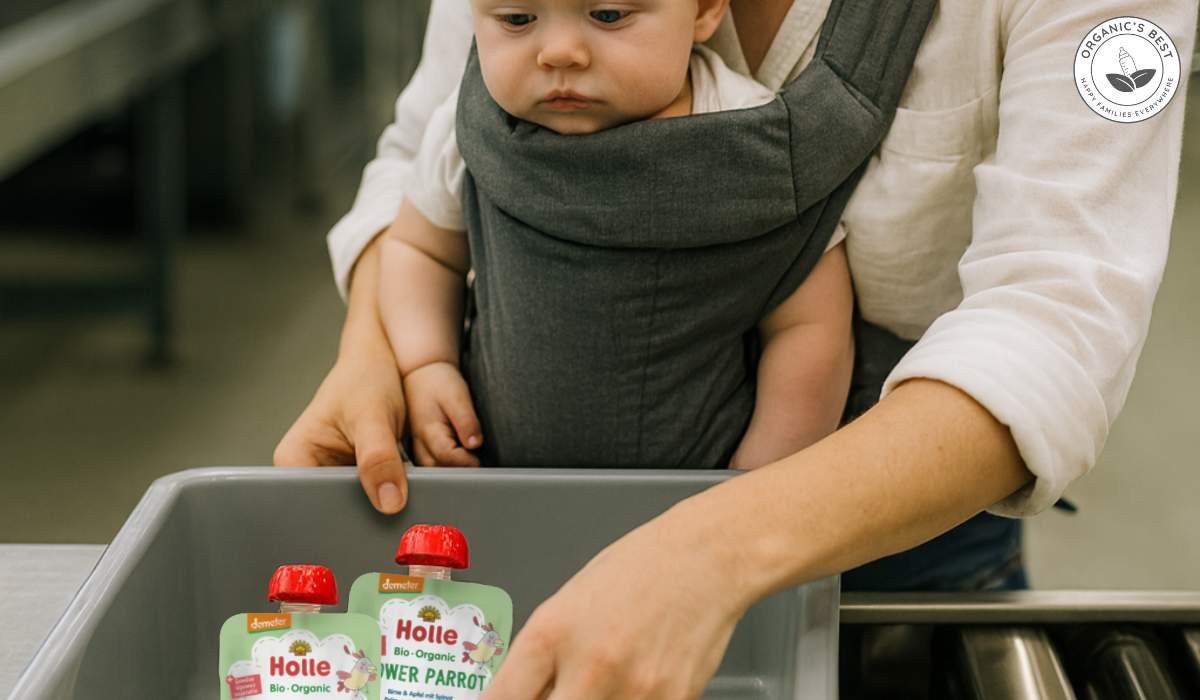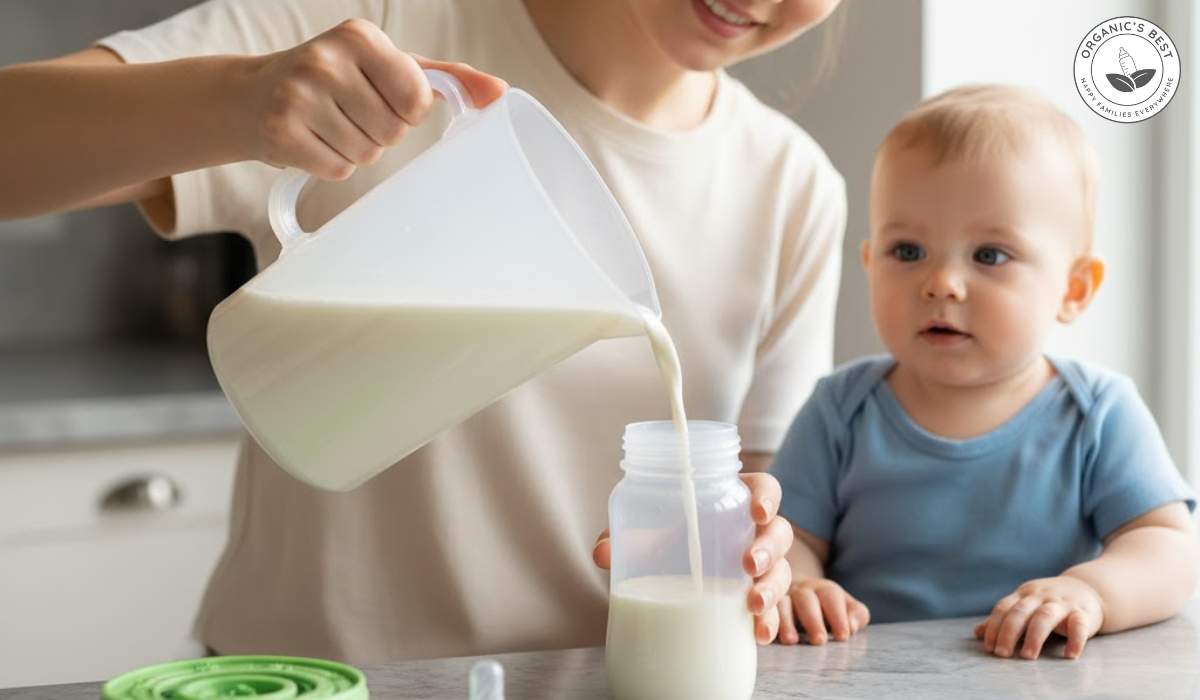Click to Get 2 FREE Boxes/Cans
Only New Customers! Click HERE to Get 2 Extra Boxes/Cans for Free With Your First Order.
BABY FORMULA
Offering new parents top-quality European infant formula from renowned brands like HiPP, Holle, Kendamil, and more. If you’re uncertain about which product to choose, our Formula Finder can help you make the best decision for your baby.
Baby Food
Offering new parents a premium selection of European baby foods, including jars, pouches, cereals, and snacks from esteemed brands like HiPP and Holle.
Simple Steps: How to Wean Baby Off Formula
by Agustina Fernandez October 31, 2023 10 min read

The first year of parenthood is a whirlwind of precious moments, sleepless nights, and countless firsts. From those first tentative steps to the delightful babbling that slowly turns into words, you've witnessed your little one's growth and development with wonder.
And now, as you stand on the brink of celebrating their first birthday, there's another significant milestone on the horizon – it might be time to say goodbye to the formula-filled bottle era!
In this comprehensive guide, we'll take you through the process of weaning your baby off formula, answering your questions, and addressing your concerns to ensure a seamless and healthy transition for your little one.
Table of contents
- The Signs: When is Your Baby Ready to Stop Drinking Formula?
- Mapping the Transition: From Formula to Other Nutritional Sources
- Toddler Formula: An Alternative to Whole Milk?
- Invitation to Explore European Toddler Formulas
- Your Step-by-Step Guide to Weaning Baby off Formula
- Tips and tricks to give your child new drinks and foods
- Hurdles Along the Way: Common Challenges and How to Overcome Them
- Bottle to Cup: Navigating the Transition
- Celebrating Success: Signs Your Baby Has Successfully Weaned Off Formula
- Your Questions Answered: Frequently Asked Questions About Weaning Off Formula
The Signs: When is Your Baby Ready to Stop Drinking Formula?
The transition from formula to solid foods is a significant milestone in your baby's development, and recognizing the signs that indicate their readiness is crucial.
Signs Your Baby Can Start Eating Solid Foods Alongside Breast Milk or Infant Formula
For roughly the first 6 months, only breast milk or infant formula will satisfy your little one's nutritional needs. Moreover, offering your baby before 4 months of age can result in a variety of health complications.
Generally, around the age of 6 months, there are three clear signals that, when they appear together, suggest your baby is ready to embark on their first solid foods alongside breast milk or first infant formula:

-
Sitting Steadily: Your baby will demonstrate the ability to sit upright with support and hold their head steady. This newfound stability is essential for safe and effective eating.
-
Coordinated Exploration: Watch for signs of coordination between their eyes, hands, and mouth. Your baby will show an interest in food, be able to gaze at it, pick it up, and attempt to bring it to their mouth independently.
-
Swallowing Proficiency: Instead of reflexively spitting out everything that enters their mouth, your baby will start to swallow food, a key indicator that their digestive system is maturing.
Some behaviours, while often misunderstood as signs of readiness for solid foods, are actually typical developmental stages and not indicative of hunger for solids. These can include chewing on fists, nighttime waking and increased milk feeds.
The Shift in Nutritional Needs as Your Baby Grows
Here's a closer look at how your baby's nutritional needs change as they grow:
The Early Months: In the first few months of life, breast milk or formula provides all the essential nutrients your baby needs. These liquid diets are specially formulated to support their rapid growth and development. Breast milk, in particular, offers antibodies and immune-boosting properties that provide protection against infections.
The Transition to Solids: As your baby reaches around 6 months of age and exhibits signs of readiness for solids, it's time to introduce new textures and flavors to their diet. Solids offer a wider array of nutrients, including vitamins, minerals, and complex carbohydrates. This transition complements the nutrition from breast milk or formula.
Key Nutrients to Keep in Mind as Your Baby Grows:

-
Iron: At around 6 months, your baby's iron stores start to deplete, which is why introducing iron-rich foods like fortified cereals, meat, and legumes is crucial (source).
-
Calcium and Vitamin D: These nutrients are vital for bone development. Milk and dairy products, as well as fortified foods, can contribute to meeting these requirements.
-
Protein: Continue to provide a source of protein, such as lean meats, poultry, fish, or plant-based options like tofu and beans, to support muscle and tissue growth.
-
Fiber: As your baby's digestive system matures, incorporating fiber-rich foods like fruits, vegetables, and whole grains can aid in digestion and prevent constipation.
-
Fats: Healthy fats, found in avocados, olive oil, and fatty fish like salmon, support brain development and overall growth.
-
Vitamins and Minerals: Ensure a varied diet to provide a spectrum of vitamins and minerals, such as vitamin C, vitamin A, and zinc, which are essential for immune function and overall health.
Even as your baby begins their transition to solid foods, remember that breast milk or formula continues to be a valuable source of both nutrition and comfort. Breastfeeding moms can continue nursing, or if your baby requires supplemental feeding, continue formula feeding alongside the introduction of solids to ensure your baby receives all the necessary nutrients.
Until your child reaches their first birthday, the solids your baby eats are not a whole meal but rather are a complement to your baby's primary diet of milk feeds.
Mapping the Transition: From Formula to Other Nutritional Sources
As your baby hits the 12-month mark and you embark on the journey of transitioning them to a more diversified diet, it's essential to understand the various options available to meet their evolving nutritional needs.
Here, we break down the key choices:

1. Cow's Milk: Switching from formula to cow's milk, which is a primary source of calcium and vitamin D, is a common choice for many families. However, it's essential to note that the transition from formula to cow's milk is not recommended until your baby reaches their first birthday.
2. Fortified Milk Alternatives: For those who prefer non-dairy options, fortified milk alternatives such as almond milk, soy milk, or oat milk can be suitable choices.
3. Toddler Formula: Some parents opt for toddler formula, specifically designed to meet the nutritional needs of children over the age of 12 months. Toddler formulas often contain added vitamins and minerals like iron, calcium, and DHA to support brain development.
4. Other Sources of Nutrition: Solid food plays a significant role in meeting your baby's nutritional needs.
Toddler Formula: An Alternative to Whole Milk?
The choice between plain whole cow's milk and toddler formula can be a perplexing one for parents as they transition their little ones into a more diversified diet. While some families opt for toddler formula, the American Academy of Pediatrics (AAP) recommends cow's milk as the primary drink for children aged 12 to 36 months (source).
However, there are specific circumstances where toddler formula might be considered:
1) Medical Conditions: If your child has a medical condition that restricts their diet or requires specialized nutritional support, consulting with a healthcare professional may lead to the recommendation of a toddler formula.
2) Severe Allergies: In cases of severe cow's milk or food allergies, cow's milk may not be a suitable option.
3) Irregular Growth: If your child experiences irregular growth patterns or struggles with specific nutritional deficiencies, a healthcare provider may recommend a toddler formula to supplement their diet and address these concerns.
While toddler formulas have their place in specific situations, the AAP's recommendation is clear: for most toddlers, offering cow's milk is the best choice to support their overall health and development.
Invitation to Explore European Toddler Formulas
If you are opting to nourish your little one with a toddler milk rather than whole cow's milk, the choice of formula matters. We offer European toddler formulas that are free from artificial sweeteners, flavors, GMOs and added sugars.
This is particularly important for parents who are concerned about the high sugar content of some conventional toddler drinks. These formulas are made using wholesome ingredients to ensure that your child receives the best possible start in their nutritional journey.
Top 4 Toddler Formulas
Here are some of our favourite toddler milks and a few points about why we love them!

-
Skimmed cow’s milk as the first ingredient
-
Lactose only, no added carbs
-
Enriched with prebiotics and probiotics
-
EU organic certified
-
Contains ARA (Omega-6) & DHA (Omega-3)
Kendamil Classic Stage 3:
-
Whole cow’s milk as the first ingredient
-
Casein-dominant protein ratio (supports a weaning diet)
-
Contains omega-3 and omega-6 essential fatty acids, including plant-based DHA
-
Contains prebiotics
-
NO starch or maltodextrin, only lactose-based
-
NO palm oil, soy, or gluten
Jovie Stage 3:
-
Whole goat's milk only, no maltodextrin or palm oil
-
Enriched with prebiotics
-
Contains DHA (Omega-3)
-
Low-allergen milk protein
-
EU organic certified
Nannycare Stage 3:
-
Whole goat's milk only, no added whey powder
-
Low-allergen milk protein
-
Free of palm oil, whey, maltodextrin, and soy
-
Contains DHA (Omega-3)
Your Step-by-Step Guide to Weaning Baby off Formula
Here's a step-by-step guide to help you navigate this important milestone:
-
Start Slowly: Begin by replacing one bottle feed with a meal of solids or a suitable alternative, such as whole cow's milk or a toddler formula.
-
Choose the Right Timing: Opt for a time when your baby is relaxed and not overly hungry or tired. This will make the transition more comfortable for both of you.
-
Observe Your Baby's Response: Pay attention to how your baby responds to the new food or drink. Some may take to it right away, while others might need time to adjust.
-
Maintain Routine: Keep the rest of your baby's feeding schedule consistent. Offer warm formula or breast milk in the usual way for the remaining feeds.
-
Increase Solid Foods: As your baby becomes more accustomed to solids, gradually increase the number of solid meals while reducing the formula feeds. This shift should happen over weeks or even months, depending on your baby's readiness.
Tips and Tricks to Give Your Child New Drinks and Foods
Introducing new foods and drinks to your baby can be an exciting but sometimes challenging endeavour. Start with familiar flavours to ease the transition and offer a variety of options to expose your baby to different tastes and textures. Be patient, as it's common for babies to be cautious about trying new foods and continue offering a variety of choices.
Lead by example by eating together as a family to encourage healthy eating habits. Avoid pressuring your baby to eat or drink something they're not interested in, as force-feeding can lead to negative associations with food.
Gradually introduce textures as your baby becomes more comfortable with solids, and create a positive mealtime environment with minimal distractions to help them focus on eating. Consistency in your feeding schedule is essential to establish routine and familiarity, supporting your baby in developing healthy eating habits for life.
Hurdles Along the Way: Common Challenges and How to Overcome Them
The weaning process can present typical challenges, including food refusal, texture preferences, fussy eating, difficulty transitioning to a sippy cup, and potential food allergies.
To manage these challenges effectively, patience and persistence are key; continue offering a variety of foods, introduce textures gradually, and maintain diverse food choices. If your toddler becomes a picky eater, stay calm and provide a balanced diet, as preferences can change over time.
Encourage the transition to cups gradually, and be vigilant about potential food allergies by introducing common allergens one at a time. Remember that each child progresses at their own pace, and with the right approach, these obstacles can be successfully navigated.
Bottle to Cup: Navigating the Transition
Introducing a cup is not just a practical milestone; it also helps your baby learn essential skills, such as sipping and swallowing, and it supports their oral and dental development.
When making this transition, opt for cups with soft, spill-proof spouts or straws that are easy for your baby to use. Start by offering just a drink of water or a small amount of milk in the cup during mealtimes, allowing your baby to explore and get used to this new way of drinking.
It's normal for spills to happen, so be patient and encouraging. Gradually reduce the number of bottle feeds, replacing them with cup offerings!
Celebrating Success: Signs Your Baby Has Successfully Weaned Off Formula
Here are some key indicators that your baby has successfully transitioned to a diversified diet:
1. Consistent Solid Food Intake: Your baby consistently accepts and enjoys a variety of solid foods, including fruits, vegetables, proteins, and grains, while showing less reliance on prepared formula servings.
2. Reduced Formula Consumption: Your baby is taking significantly less formula, and they are no longer relying on it as a primary source of nutrition.
3. Comfortable with Cups: Your baby has adapted to cup feeding, gradually phasing out the need for bottles.
4. Age-Appropriate Growth: Your baby continues to grow and thrive, meeting developmental milestones and maintaining a healthy weight.
5. Positive Eating Habits: Your baby displays positive eating habits, such as self-feeding, trying new foods, and demonstrating an appetite for a variety of flavors and textures.
Your Questions Answered: FAQs About Weaning Off Formula
Navigating the weaning process can bring up many questions for parents. Here are answers to some of the most commonly asked questions:
When Should I Start Weaning My Baby off Formula?
The ideal time to start weaning your baby off formula is typically around your baby's first birthday. At this stage, many babies are ready to transition to whole milk or suitable milk alternatives while gradually incorporating a variety of other foods into their diet.
Can You Just Stop Formula and Switch to Whole Milk?
While some may transition smoothly from baby formula to whole cow's milk, it's generally recommended to make this shift gradually. Abruptly stopping formula and introducing whole cow's milk can be hard on your baby's digestive system.
How Do I Transition My 1-year-old to Milk?
To transition your 1-year-old to cow's milk, slowly replace formula with whole milk while bottle feeding. Begin by offering a small amount of whole milk mixed with formula, and gradually offer more milk while decreasing the formula your baby drinks.
Conclusion
As your baby's bottle era draws to a close, it's a poignant moment to reflect on the incredible journey you've both experienced together. From those early days of formula feeding to the exciting world of solid foods, you've witnessed your child's growth and development, both physically and nutritionally. Remember that every child's journey is unique, and with patience, flexibility, and the guidance of your pediatrician, you will be able to wean your baby off formula successfully!
Disclaimer:
Please be aware that this information is based on general trends in babies, and it is not medical advice. Your doctor should be your first source of information and advice when considering any changes to your child’s formula and when choosing your child’s formula. Always consult your pediatrician before making any decisions about your child’s diet or if you notice any changes in your child. Breastfeeding is the best nutrition for your baby because breast milk provides your child with all the essential nutrients they need for growth and development. Please consult your pediatrician if your child requires supplemental feeding. |
Agustina Fernandez
Dr. Agustina Fernandez earned her medical degree from the prestigious Universidad Nacional de Córdoba, Argentina. With a deep-rooted passion for pediatrics, Dr. Fernandez is currently on the path to specializing in children's healthcare. Recently, she has delved into the vital field of infant nutrition. Her research interests include breastfeeding, infant formula, and baby food in little ones’ formative years. Dr. Fernandez's commitment to this area of study underscores her dedication to ensuring the health and well-being of children from their earliest days.
Leave a comment
Comments will be approved before showing up.
Also in Organic Infant Nutrition and Health Blog

Everything You Need To Know About Winter Pregnancy: Essential Tips for Moms-to-be
by Agustina Fernandez December 16, 2025 8 min read
Read More
Can You Bring Baby Food Pouches on a Plane? Essential Tips for Parents
by Agustina Fernandez December 09, 2025 7 min read
Read More
The Formula Pitcher: Is It Safe To Make A Whole Pitcher Of Baby Formula?
by Agustina Fernandez December 02, 2025 8 min read
Read More
Reviewed by Dr. Bardha Citaku, MD
-

Dr. Bardha Citaku: Medical Reviewer of Organic's Best Blog
Dr. Bardha Citaku completed her medical studies at the University of Prishtina in Kosovo, where she began her journey into the field of medicine. She has since developed a career in medical research, contributing to projects with notable organizations, including the World Health Organization (WHO).
